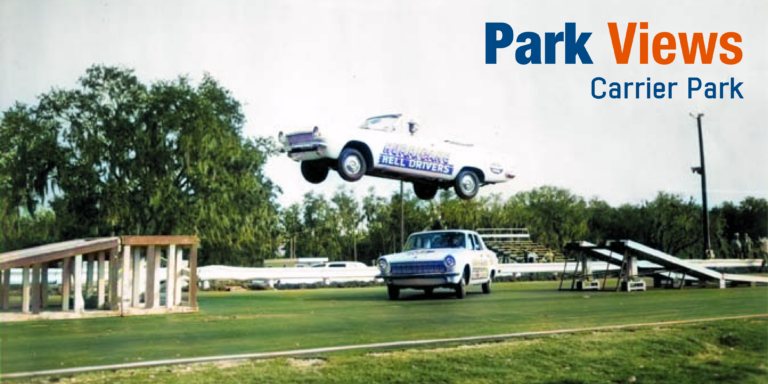This entry is part of Park Views, a weekly Asheville Parks & Recreation series that explores the history of the city’s public parks and community centers – and the mountain spirit that helped make them the unique spaces they are today. Read more from the series and follow APR on Facebook and Instagram for additional photos, upcoming events, and opportunities.
In the 1950s, pollution was so bad that the river that runs through the heart of Asheville was considered “dead” and several native fish and aquatic species became extinct. Though it took decades, a group dedicated to a social, environmental, and economic vision to protect the French Broad River and other local waterways created a riverfront renaissance. Their story includes the creation of Carrier Park, a place brimming in recreational history.
Early River Recreation
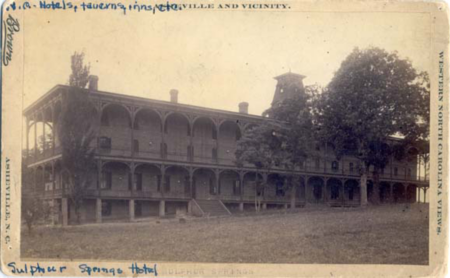 Asheville’s riverfront recreation dates back thousands of years, with the confluence of the French Broad and Swannanoa rivers roughly marking the eastern boundary of Cherokee (ᎠᏂᏴᏫᏯᎢ) homelands in western North Carolina that included towns and villages, complete with defensive palisades, hunting grounds, and plazas for sports and play along the riverbanks. Many of the trails they established along waterways and through forests for travel, food gathering, recreation, and commerce eventually turned into stagecoach trails like Buncombe Turnpike, then railroads, and eventually modern roads and greenways.
Asheville’s riverfront recreation dates back thousands of years, with the confluence of the French Broad and Swannanoa rivers roughly marking the eastern boundary of Cherokee (ᎠᏂᏴᏫᏯᎢ) homelands in western North Carolina that included towns and villages, complete with defensive palisades, hunting grounds, and plazas for sports and play along the riverbanks. Many of the trails they established along waterways and through forests for travel, food gathering, recreation, and commerce eventually turned into stagecoach trails like Buncombe Turnpike, then railroads, and eventually modern roads and greenways.
Factories appeared along the river when the railroad arrived in the 1880s, transforming Asheville from a livestock town into the region’s economic center. For the next several decades, the riverfront district operated as one of the area’s primary industrial areas due to its proximity to the railway.
Also in the 1880s, Edwin Carrier began developing West Asheville. As owner of Sulphur Springs Hotel, Carrier implemented an electric trolley system in 1891 to ferry passengers to his hotel and saw potential in opening a race track along the French Broad River for the entertainment of his guests.
Carrier’s Impact
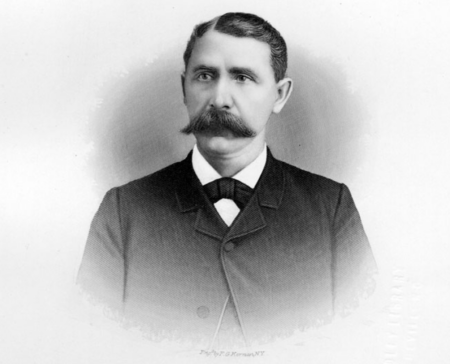 Carrier and his family were on a trip from their home in Pennsylvania to Florida when they passed through Asheville in 1885. Immediately impressed by its beauty, climate, and friendly atmosphere, they decided to settle in the little city.
Carrier and his family were on a trip from their home in Pennsylvania to Florida when they passed through Asheville in 1885. Immediately impressed by its beauty, climate, and friendly atmosphere, they decided to settle in the little city.
Carrier had previously garnered a large fortune in the lumber business, leaving ample funds to carry out plans for his new hometown. Shortly after arrival, he began purchasing what eventually became 1,200 acres of land west and north of the French Broad River. He formed the West Asheville Improvement Company and began the modern development of Haywood Road.
As the first of his projects, he built Sulphur Springs Hotel in 1886, a three story brick structure that became one of Asheville’s most popular tourist resorts. Its name changed to Carrier Springs and then to The Belmont. In 1889, a wing was added that included the first passenger elevator in the southeastern United States.
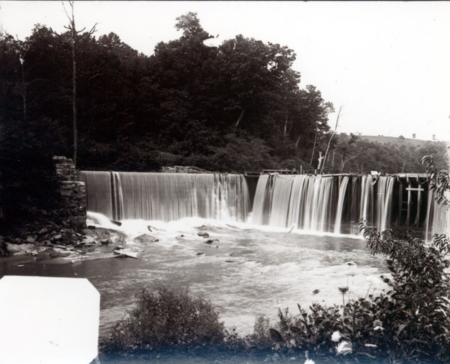 The same year, he built a low wooden dam across Hominy Creek and constructed a power plant. Equipped with a 60-horsepower turbine and 40-kilowatt generator, it was the first hydroelectric plant in western North Carolina and the first of its kind to provide power to a commercial street car. It provided the first reliable electric lights in Asheville – after its service to The Belmont, of course.
The same year, he built a low wooden dam across Hominy Creek and constructed a power plant. Equipped with a 60-horsepower turbine and 40-kilowatt generator, it was the first hydroelectric plant in western North Carolina and the first of its kind to provide power to a commercial street car. It provided the first reliable electric lights in Asheville – after its service to The Belmont, of course.
Also in 1889, he built Carrier’s Bridge, a 250-foot steel bridge spanning the French Broad at its junction with the Swannanoa. Soon after, construction began on the West Asheville and Sulphur Springs Electric Railway that ran from a passenger station across Carrier’s Bridge along present-day Amboy Road and up by Hominy Creek to Sulphur Springs and The Belmont.
Among his many other projects was creation of a race track in 1892 near today’s Carrier Park. The large tract of land also served as fairgrounds and was used for baseball games, bicycle races, trotting races, and many other activities. It soon became known as Carrier’s Field. Daily crowds of more than 1,500 came to enjoy the region’s first large sports field.
The twin tragedies of the loss of The Belmont to fire in 1892 and his orange groves in Florida drew Carrier away from Asheville and back to his first financial interest, the lumber business. Even though he spent the latter 20 years of his life away from the city, his body was returned after his death in 1927 and buried at Riverside Cemetery.
New Asheville Motor Speedway
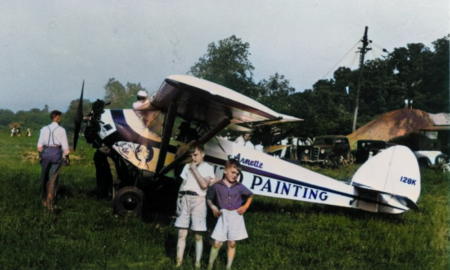 Carrier’s Field served a variety of purposes over the following decades, notably as a small local airport opened by Dr. J.E. Owen in 1925. Owen was a local dentist, barnstorming pilot, and inventor. He was a World War II bombardier and became a commercial pilot for Eastern Air Express Lines after the war. Owen Field also hosted circuses, air shows, and other entertainment on the riverfront.
Carrier’s Field served a variety of purposes over the following decades, notably as a small local airport opened by Dr. J.E. Owen in 1925. Owen was a local dentist, barnstorming pilot, and inventor. He was a World War II bombardier and became a commercial pilot for Eastern Air Express Lines after the war. Owen Field also hosted circuses, air shows, and other entertainment on the riverfront.
The New Asheville Speedway, nicknamed “The River,” opened on the site in 1960 as a 1/3-mile dirt track. At least once during the track’s first year, an airplane landed on the runway in the middle of a race.
In 1961, the track was paved and Asheville was treated to exciting short-track races. According to newspaper articles, the rivalries between local racers were intense and many fans came as much for the fights that often took place during and after races as for the races themselves.
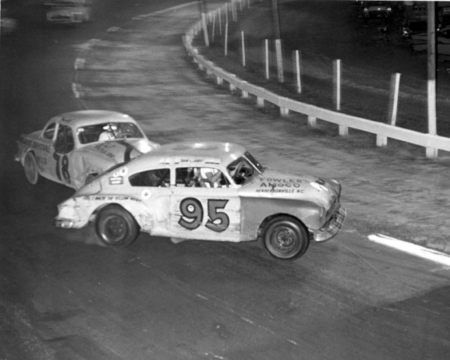 Bob Greenwood purchased the track from its builders and did as much as possible to keep rivalries alive and stands full by offering drivers under-the-table payments or free tires if they would wreck a rival, according to the speedway memorial in Carrier Park. Track announcer Shug Thompson further enlivened the festivities with inventive nicknames for drivers and such colorful phrases as, “Here they come, all lined up like grandma’s onions.”
Bob Greenwood purchased the track from its builders and did as much as possible to keep rivalries alive and stands full by offering drivers under-the-table payments or free tires if they would wreck a rival, according to the speedway memorial in Carrier Park. Track announcer Shug Thompson further enlivened the festivities with inventive nicknames for drivers and such colorful phrases as, “Here they come, all lined up like grandma’s onions.”
The New Asheville Speedway hosted eight races on the NASCAR Grand National circuit from 1962-1971 with winners including Junior Johnson and Richard Petty. In the 1980s and 1990s, the speedway had a great deal of success with Late Model division races.
River Recovery
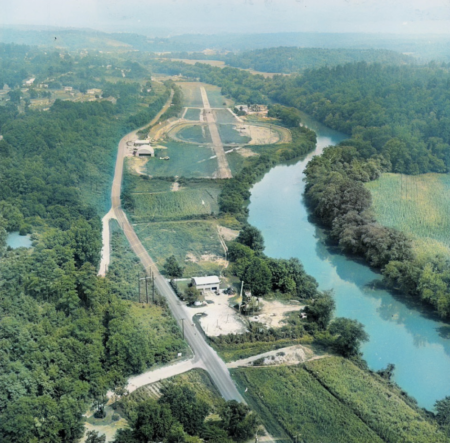 Spectators may have filled speedway stands on Friday nights, but residents and businesses had largely left the riverfront behind to auto graveyards, junkyards, abandoned buildings, and rundown factories that straight-piped waste directly into the river. By the 1950s, population growth and river district industrialization turned the French Broad into an open cesspool with floating garbage, landfill seepage, and chemical runoff, documented in Wilma Dykeman’s The French Broad.
Spectators may have filled speedway stands on Friday nights, but residents and businesses had largely left the riverfront behind to auto graveyards, junkyards, abandoned buildings, and rundown factories that straight-piped waste directly into the river. By the 1950s, population growth and river district industrialization turned the French Broad into an open cesspool with floating garbage, landfill seepage, and chemical runoff, documented in Wilma Dykeman’s The French Broad.
In the late 1970s, only one riverside park existed for public use in Buncombe County, Sandy Bottoms-Bent Creek Park. The lack of public access to the river was a major problem for recreational canoeists, hunters, and people looking to fish.
Following decades of work by locals committed to rescuing the French Broad River, Asheville’s Riverfront Plan was unveiled in 1989 and French Broad River Park opened in 1995. That park expanded to include a trail to a fishing dock in Amboy Riverfront Park within a few years. The trail then expanded to a new park located on the speedway grounds.
Asheville’s Most Visited Park
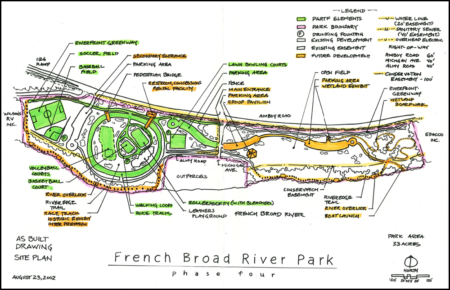 Environmental nonprofit RiverLink purchased New Asheville Motor Speedway in 1998 with intentions to create a new park. The City of Asheville acquired the property from RiverLink, though Asheville Parks & Recreation (APR) worked closely with the nonprofit to create the park. The land was leased to Carolina Motorsports in 1999 for $200,000 so fans could enjoy a final season of racing at the speedway. Proceeds from the lease benefited design and development of Carrier Park.
Environmental nonprofit RiverLink purchased New Asheville Motor Speedway in 1998 with intentions to create a new park. The City of Asheville acquired the property from RiverLink, though Asheville Parks & Recreation (APR) worked closely with the nonprofit to create the park. The land was leased to Carolina Motorsports in 1999 for $200,000 so fans could enjoy a final season of racing at the speedway. Proceeds from the lease benefited design and development of Carrier Park.
Following a series of public meetings, APR and RiverLink implemented an ambitious fundraising plan to raise more than $2 million for the park, which would include the most recreational diversity possible within its 33 acres. As funding sources were secured, the plan came to life.
Sweat equity from volunteers during a community playground build in 2001 provided momentum to complete the first phase of the park, dedicated in 2003 and including a volleyball court, roller hockey rink, playground, basketball court, lawn bowling, and trails. The speedway’s asphalt track was incorporated as a velodrome for 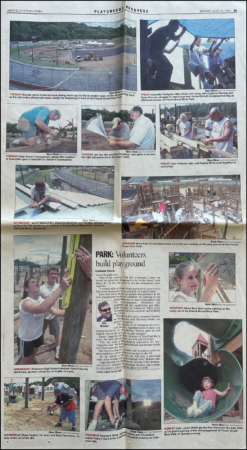 biking and skating. The unique amenities made the park the home base of Mountain Sports Festival for many years.
biking and skating. The unique amenities made the park the home base of Mountain Sports Festival for many years.
Carrier Park initially began as French Broad River Park “Phase IV,” since the original vision was a large linear park stretching along the banks of the river. The first phase of this vision resulted in French Broad River Park, the second added an additional walking loop in that park, and the third phase created Amboy Riverfront Park and the trail linking it to French Broad River Park. The trail between those parks became French Broad River Greenway, which today runs uninterrupted between Buncombe County Parks & Recreation’s Hominy Creek River Park and Craven Street.
Realizing the park needed its own name, APR worked for almost a year with RiverLink, West Asheville neighborhoods, and park user groups. Carrier Park was chosen to honor the Carrier family that had been so instrumental in development of West Asheville. Following construction delays from Hurricanes Frances and Ivan, the second phase of the park was dedicated in 2006 with a large picnic shelter, river overlook, wetland interpretive area, and more trails.
As Carrier Park became (and remains) Asheville’s most visited park, APR developed other large public recreation areas such as Azalea and Richmond Hill parks to bring many new recreation opportunities to the people who live here. Its rich history continues as Ashevillians make new memories at Carrier Park every day.
Do you have photos or stories to share about Carrier Park? Please send them to cbubenik@ashevillenc.gov so APR can be inspired by the past as we plan our future.
Photo and Image Credits
- Hurricane Hell Drivers performing a stunt at New Asheville Motor Speedway. A convertible drives off a ramp while another car drives under it. Bleachers behind the guardrail were relocated to Memorial Stadium. Courtesy of Buncombe County Special Collections, Pack Memorial Public Library, Asheville, North Carolina.
- Sulphur Springs Hotel was located near School Road in Malvern Hills. An original wooden hotel burned to the ground in 1861. Carrier built the brick hotel pictured here near the springs in 1887. It was destroyed by fire again in 1892, but concrete ruins remain. Courtesy of Buncombe County Special Collections, Pack Memorial Public Library, Asheville, North Carolina.
- This portrait of Edwin Carrier is an engraving by F.G. Kernan of New York probably made about the time Carrier brought his family to Asheville in 1885. Courtesy of Buncombe County Special Collections, Pack Memorial Public Library, Asheville, North Carolina.
- Hominy Creek’s power plant dam was 30 feet high and 250 feet long two miles southeast of his hotel. Courtesy of Buncombe County Special Collections, Pack Memorial Public Library, Asheville, North Carolina.
- Bill and Fred Ruby pose by a plane at Owen Field (also known as Carrier Field). Courtesy of Buncombe County Special Collections, Pack Memorial Public Library, Asheville, North Carolina.
- A common scene during a night race at New Asheville Speedway in a night time race.. Courtesy of Buncombe County Special Collections, Pack Memorial Public Library, Asheville, North Carolina.
- Aerial view of French Broad River looking downstream. The 1/3-mile dirt race track is in the center. Courtesy of Buncombe County Special Collections, Pack Memorial Public Library, Asheville, North Carolina.
- An early rendition of Carrier Park shows a variety of recreational amenities and access to the river.
- A three-day community playground build resulted in Carrier Park’s popular playspace, regularly voted the best in the region. The final day included a potluck celebration. Expanded over the years, the playground is set to receive a full makeover in 2024.
